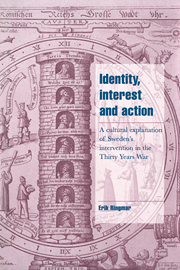 Identity, Interest and Action
Identity, Interest and Action Book contents
- Frontmatter
- Contents
- List of illustrations
- Acknowledgements
- Introduction: the beginning of the story
- Part I A narrative theory of action
- 1 Historical and scientific explanations
- 2 The modern orthodoxy
- 3 A narrative theory of action
- Part II Why did Sweden go to war in 1630?
- Conclusion: the end of the story?
- Notes
- Bibliography
- Index
2 - The modern orthodoxy
Published online by Cambridge University Press: 21 October 2009
- Frontmatter
- Contents
- List of illustrations
- Acknowledgements
- Introduction: the beginning of the story
- Part I A narrative theory of action
- 1 Historical and scientific explanations
- 2 The modern orthodoxy
- 3 A narrative theory of action
- Part II Why did Sweden go to war in 1630?
- Conclusion: the end of the story?
- Notes
- Bibliography
- Index
Summary
If we turn away from the context of the Swedish intervention for a moment, we will find that the consensus which the previous chapter documented is only a special case of a more general consensus on how actions should be explained. Despite wide disagreements regarding almost all other issues, modern scholars tend to agree on the simple proposition that individual human beings, but also collective entities of various kinds, act in their interests. That is, they do what they do because it is in their interest to do it. Since this is the case, it seems an outside observer – a historian or a social scientist – would be justified in invoking those same interests in an explanation of why an individual or a group did a certain thing. On the basis of this reasoning historians have sought to come up with ‘rational reconstructions’ of the intentions of historical personae, economists have assumed the existence of ‘rational actors’, and social scientists have explained everything from voters’ behaviour to the propensity of workers to go on strike by the extent to which a certain action on balance provides more ‘utility gain’ than another. In fact, even radical critics such as Marxists or feminists have agreed that social classes, or gendered beings, act in terms of their ‘class interests’ or the interests of their sex.
The only point of contention here concerns the degree to which people are in fact able to live up to the rationalistic ideal.
- Type
- Chapter
- Information
- Identity, Interest and ActionA Cultural Explanation of Sweden's Intervention in the Thirty Years War, pp. 44 - 65Publisher: Cambridge University PressPrint publication year: 1996
